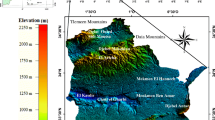Abstract
Godavari sub-watershed is a part of buried pediplain developed over ‘Chotanagpur’ granite gneiss. Aquifer is unconfined in nature and groundwater occurs under water table condition. In the study area, groundwater is being exploited only through dugwells which are not capable of sustaining long duration pumping. Groundwater exploration involves the investigation of depth and nature of weathered and fractured horizon. To understand the groundwater storage and retrieval in the area, the basement topography derived from Digital Basement Topography Modelling (DBTM), the lineaments identified on remotely sensed data and geohydrological and physiographic data have been analysed. From DBTM, fracture zones have also been inferred. Lineaments (probable fractures) identified with the help of remotely sensed data are linear features representated on a planner surface. Lineaments in the area are subtle in expression due to deeply buried pediplian. Correlation of lineaments with DBTM reveals that a few lineaments/fractures are deep seated and a few have no sub-surface extensions. Also some sub-surface fractures inferred from DBTM have no expressions on the image. Attempt has been made to delineate more authentic lineaments/fractures with the help of remotely sensed data and DBTM. Correlation of probable fractures inferred from remotely sensed data and fracture zones inferred from DBTM indicated that 40 per cent of lineaments seems to be real fractures. Higher correlation may be achieved where lineaments are prominent and reproducible. It has also been observed that those lineaments which correlate with the fracture zones inferred from DBTM, are also not completely traceable in their linear extent. The exaggeration in length of lineaments may be due to subtle nature of lineaments. Correlation shows that remotely sensed lineaments are improtant for groundwater exploration and its authenticity can be further ascertained with DBTM.
Similar content being viewed by others
References
AIS & LUS (1988). Watershed atlas of India. All India Soil & Land Use Survey, New Delhi.
Khan Ali and Haider S (1987). Hyderogeology and Ground Water Resources Development Potential of Ranchi, Lohardagga and Gumla Districts of Bihar, Central Ground Water Board Technical Report, Series — D, No. 46.
Kumar Ashok (1998). Aquifer geometry scanning in Usri watershed, Giridih, Bihar — an geophysical analysis. Project Report, DST-BCST, Patna, pp. 1–110.
Kumar Ashok, Sinha Ranjan and Prasad B B (1997). Digital Basement Terrain Modelling (DBTM) — a tool for sustainable utilisation and management of groundwater in hard rock area. Nat. Conf. on Emerging Trends in Development of Sustainable Groundwater Sources held at JNTU, Hyderabad from Aug. 27–28, 1997.
Nath Sambhu Singh K.K., and Sekhar Sudhanshu (1991). Hydrogeology and groundwaterresources of Giridih district, Bihar, Unpublished Report, Central Ground Water Board, Calcutta, pp. 8–19.
Zohdy A. A. R. (1989). A new method for automatic interpretation of Schlumberger and Wenner sounding curves, Geophysics, 54 (2): 245–253.
Author information
Authors and Affiliations
About this article
Cite this article
Kumar, A., Tomar, S. & Prasad, L.B. Analysis of fractures inferred from DBTM and remotely sensed data for groundwater development in godavari sub-watershed, Giridih, Bihar. J Indian Soc Remote Sens 27, 105–114 (1999). https://doi.org/10.1007/BF02990806
Received:
Revised:
Issue Date:
DOI: https://doi.org/10.1007/BF02990806




